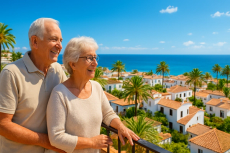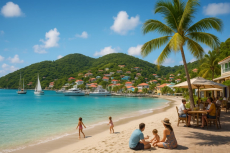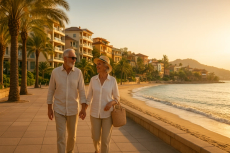Blog • Published on:July 2, 2025 | Updated on:July 29, 2025 • 9 Min
Living La Dolce Vita: Your Guide to Retirement in Italy
If you can retire in a place that’s warm, wired into history, has reliable healthcare, affordable living in many parts, and that much-desired slower pace, why not?
Italy doesn’t shout about it, but it offers all of the above. And for retirees who aren’t looking to disappear into isolation or spend a fortune maintaining a lifestyle, that’s worth paying attention to.
And yes, the country makes it legally possible to retire there, even for non-EU citizens. So, if the idea of switching off the autopilot and stepping into a more deliberate way of life sounds appealing, this guide walks you through exactly how to do it.
Why It’s Actually Worth Retiring in Italy
Who is Italy right for?
Retiring in Italy makes sense if you’re financially self-sufficient, not tied to a fast-paced environment, and looking for a country where daily life still has structure and routine. It works well for people who:
- Have stable income from pensions, rentals, or investments
- Prefer living in smaller cities or towns where walking is the norm
- Want access to public healthcare without the high premiums
- Value a bit of calm, but still want to stay connected
- Are interested in living in the EU with long-stay residency options
- Aren’t trying to “escape” but want something more manageable
This isn't a move for the ultra-wealthy. It's for people who think long-term and want clarity, healthcare, and affordability without trading away comfort.
Benefits of Retiring in Italy
1. Public Healthcare Access
Italy’s national healthcare system (SSN) is available to legal residents and offers comprehensive services at low cost. Retirees can register once they’ve secured residency, and costs are based on income, not age.
2. Lower Cost of Living
Outside major cities like Milan or Rome, many areas are surprisingly affordable. In southern regions like Calabria or inland Puglia, day-to-day expenses—groceries, transport, local services, are often a fraction of what you'd spend in the US, Canada, or UK.
3. Property Prices That Make Sense
You can find homes under €100,000 in many towns, especially in lesser-known regions. Italy also has programs to encourage foreign homeownership in rural areas, and renovation rules are straightforward.
4. A Slower Pace That’s Built-In
Time isn’t monetized the same way in Italy. Stores close mid-day, weekends are actually for resting, and small towns still run on rhythm over rush. You don’t have to force a slower lifestyle, it’s already there.
5. Culture Without a Price Tag
You don’t need to live in a capital city to have access to music, exhibitions, or architecture. Many towns offer free public events, local festivals, and government-supported cultural spaces.
6. A Clear Visa Option
The Elective Residence Visa exists specifically for non-EU citizens with passive income who want to live in Italy long-term. It’s one of the most accessible retirement visas in Europe.
7. Safety and Community
Italy has low rates of violent crime and strong community-based living, especially outside urban centers. Neighbors tend to know each other, and most towns are walkable and secure.
8. Strong Connectivity
Even if you live in a smaller town, you’re rarely far from a train station. Italy is well connected, domestically and internationally, through rail, regional airports, and Schengen travel.
Are people really doing this?
Yes, and the numbers are growing. Retirees are moving not just to the well-known places, but to quieter areas where life is simpler and property is still accessible.
Some local municipalities have even introduced incentives to attract retirees, from property tax breaks to subsidized health insurance registration, especially in areas affected by population decline.
Italian Retirement Visa Requirements
Italy does not have a visa labeled specifically as a “retirement visa.” For non-EU citizens, the route used to retire in Italy is called the Elective Residence Visa (ERV). This visa is designed for financially self-sufficient individuals who want to live in Italy long-term without working.
Elective Residence Visa (ERV)
- The ERV allows non-EU citizens to reside in Italy if they can demonstrate passive income that fully covers their living expenses.
- It is intended for retirees, long-term travellers, or financially independent individuals who do not plan to work in Italy.
Financial Requirements
Income must come from passive sources only, such as pensions, rental income, annuities, dividends, or savings interest.
Active income (employment, freelance work, consulting, etc.) is not accepted under this visa.
Minimum income requirement:
- €31,000 per year for you
- €38,000 for you and your spouse
- 20% extra for each dependent
Assets and savings: Some consulates also require proof of significant savings, especially if passive income is close to the minimum threshold.
Requirements vary slightly by consulate. Always check the consulate with jurisdiction over your home address.
Documentation Needed
You must apply at the Italian consulate in your country of legal residence. Applications are not accepted inside Italy. Required documents include:
- Valid passport (minimum 3 months beyond visa duration)
- Proof of permanent passive income (bank statements, pension statements, rental contracts, etc.)
- Recent tax returns (where applicable)
- Proof of long-term accommodation in Italy (rental contract, property deed, or invitation letter)
- Proof of comprehensive private health insurance valid in Italy, minimum coverage of €30,000
- Completed visa application form
- Passport-size photographs (typically 2)
- Criminal background check (only required by some consulates)
Application Timeline
- Submission: At the Italian consulate in your country
- Processing time: Typically, 30 to 90 days, but delays are common
- Visa validity: 1 year
- Renewal: Renewable annually from within Italy, provided financial and accommodation requirements continue to be met
- Residency permit (Permesso di Soggiorno): Must be applied for within 8 days of arrival in Italy
Best Places to Retire in Italy
Tuscany
Smaller Tuscan cities like Lucca, Arezzo, and even parts of Siena offer a well-run environment for long-term residents.
Healthcare access is strong; hospitals are modern, public systems are efficient, and most municipalities are used to processing residency permits for foreign nationals.
Public transport links are excellent, and there’s enough year-round population to avoid the seasonal shutdowns you’ll find in more tourist-heavy areas.
Housing costs are higher here compared to the south, but the trade-off is predictability and easier integration.
Budget-wise, plan for around €2,000/month for a modest lifestyle if renting.
Sicily
Sicily is one of the few places where you can still buy a habitable home for under €80,000 in a decent area.
Coastal towns like Sciacca or inland centers like Modica and Ragusa offer walkable living, access to regional hospitals, and local administrations that are beginning to streamline the residency process.
English isn’t widely spoken in smaller towns, but that hasn’t stopped retirees from settling in.
Monthly living expenses, including rent, often fall under €1,500 if you avoid high-tourism areas.
Puglia
Southern, flat, and built around agriculture and small commerce, Puglia has grown quietly popular among long-term expats.
Towns like Lecce, Ostuni, and Martina Franca offer good healthcare access, a stable year-round population, and properties often priced well below national averages.
You get regional trains, proximity to two international airports, and town centers that are compact and easy to navigate.
It’s also one of the better regions for registering residency thanks to streamlined municipal processes.
Abruzzo
Abruzzo balances inland mountain villages with Adriatic coastal towns, making it one of the few regions where you can retire near the sea or surrounded by forests, without paying premium prices.
Towns like Sulmona or Vasto remain under the radar but offer decent hospitals, clean urban planning, and a solid public transport network.
Importantly, Abruzzo is part of Italy’s 7% flat-tax incentive for foreign pensioners who move to smaller municipalities.
Lake Como (Lombardy)
Retirees with higher budgets often look to Lake Como for its access to private medical care, excellent infrastructure, and proximity to Milan and Switzerland.
It’s polished, international, and expensive, but for those prioritizing healthcare, mobility, and personal security, it ticks every box.
Towns like Menaggio or smaller villages across the lake maintain year-round services, and private insurance is commonly accepted.
Expect to spend upwards of €3,000/month to live comfortably here.
Practical Steps to Retire in Italy
Planning Timeline
Start at least 6–8 months in advance.
Here’s the typical sequence:
- 3–4 months before applying: Confirm income documentation, research regions, and check your local Italian consulate’s specific requirements.
- 2–3 months before: Book a visa appointment and begin compiling required documents (income proof, housing, health insurance).
- Visa approval: Once issued (typically 30–90 days), you must enter Italy within the visa’s validity window.
- Within 8 days of arrival: Apply for your Permesso di Soggiorno (residency permit) at the local immigration office (Questura).
Housing Search Tips
- You must show a long-term housing contract for your visa, either rental or ownership.
- Temporary Airbnb-style stays won’t be accepted by consulates.
- Property purchases are allowed before moving, but residency registration requires the property to be habitable and registered.
- If renting: Aim for towns that already process foreign residency, you’ll avoid delays.
Note: Have your rental contract signed and officially registered (via the Italian Revenue Agency) before your visa appointment.
Required Registrations
After arriving in Italy:
- Apply for Permesso di Soggiorno at the Post Office, then attend fingerprinting at the local Questura.
- Register with the Anagrafe (local registry) to establish residency in your municipality.
- If applying for access to public healthcare, enroll with the Azienda Sanitaria Locale (ASL) after registering residency.
Utility Setup
If buying a home or renting long-term:
- Electricity, gas, and water must be transferred to your name or reactivated.
- Many providers require an Italian tax code (Codice Fiscale), which you can get at the Italian Revenue Agency (Agenzia delle Entrate).
- Internet setup may take 2–3 weeks, especially in rural areas, plan ahead.
Planning Your Retirement in Italy
Retiring in Italy takes planning, but it’s a move that rewards structure with simplicity. If you approach it with the right timeline, paperwork in order, and realistic expectations, Italy offers more than just a change of scenery, it offers a system you can actually live in, day to day, without burning out your budget or energy.
And once you're settled, it quietly delivers exactly what a lot of people are looking for: space, rhythm, and the freedom to live on your own terms.
FAQs on Retiring in Italy
1. Can foreigners retire in Italy legally?
Yes. Non-EU citizens can retire in Italy using the Elective Residence Visa, which requires proof of passive income and private health insurance.
2. How much income do I need to retire in Italy?
Typically, around €31,000/year for singles and €38,000–€40,000+ for couples, from non-employment sources like pensions or investments.
3. Do retirees get access to Italy’s public healthcare?
Yes, after getting your residency permit, you can register with the public system (SSN), often by paying an annual fee based on your income.
4. Can I buy property in Italy as a retiree?
Yes. There are no restrictions for most nationalities, and you don’t need to be a resident to purchase property.
5. How long does it take to get residency after moving?
Once in Italy, you must apply for a Permesso di Soggiorno within 8 days, and it usually takes 1–3 months to receive it.
References
Institute Nazionale di Statistica (ISTAT). (2024). 2024 Annual Report – The State of the Nation. Retrieved from https://www.istat.it/en/publication/2024-annual-report-the-state-of-a-nation/
Numbeo. (2025). Cost of Living in Italy. Retrieved from https://www.numbeo.com/cost-of-living/country_result.jsp?country=Italy
Organisation for Economic Co-operation and Development (OECD). (2023). Italy: Country Health Profile 2023. Retrieved from https://www.oecd.org/en/publications/italy-country-health-profile-2023_633496ec-en.html
European Commission. (2024). Health at a Glance: Europe 2024. Retrieved from https://health.ec.europa.eu/state-health-eu/health-glance-europe/health-glance-europe-2024_en
Written By

Alice Emmanuel
Alice Emmanuel is an expert in residency and citizenship by investment, specializing in government compliance and program optimization. With over 8 years of experience, she has guided high-net-worth individuals through acquiring global mobility and new citizenships, particularly in Europe, the Caribbean, and the Middle East. Alice's in-depth knowledge of Middle Eastern residency programs makes her a trusted advisor for investors seeking security and diversification in the region.
Related Articles









Recently Published









Book a free consultation


